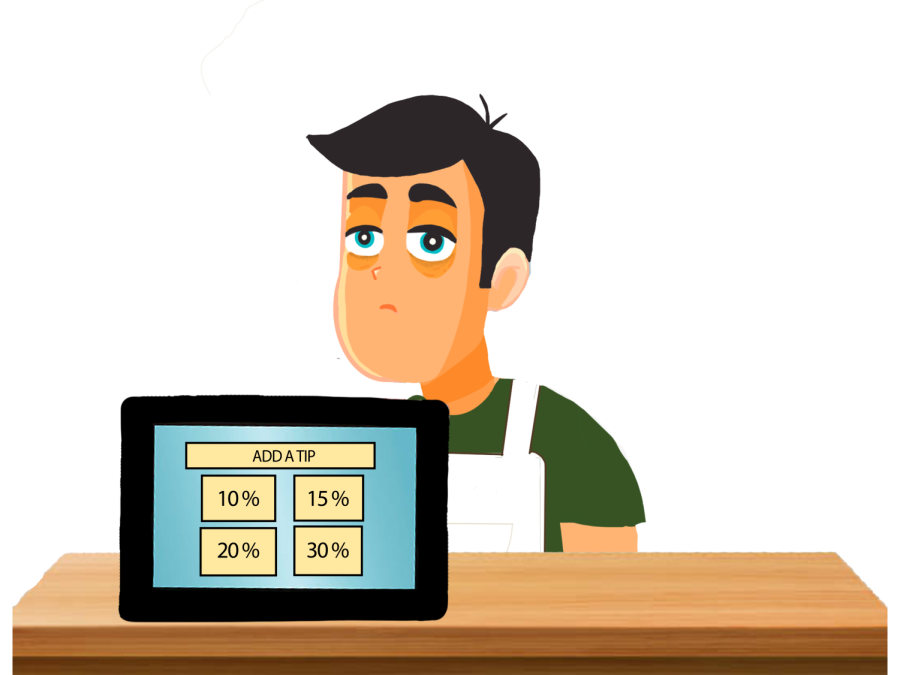Tipping culture has reached its tipping point
Graphic illustration by Deeksha Raj
An exhausted service worker awkwardly awaits as a customer is deciding how much to tip — or if to tip at all.
March 10, 2023
“One latte. That’ll be $5.45,” the cashier says. She turns the register screen around to face you, and so the internal monologue begins. The numbers stare you down, 10%? 15%? 20%? How much is appropriate? Should you be tipping for coffee at all?
Tipping gained ubiquity in the U.S. following the passage of the 15th Amendment in 1869, when Black men were given the right to vote following the abolition of slavery and the naturalization of Black Americans. After gaining freedom, many Black Americans found employment in the food service and rail industries, where White business owners often weren’t keen to adequately pay them. Introduced to the U.S. three decades earlier by wealthy patrons who learned of tipping from trips to Europe, business owners instead opted to rely on tips which allowed businesses to pay Black workersinhumanely low wages. Despite bans on tipping enacted in order to prevent low wages, tipping was codified in 1938 under the New Deal.
To this day, many businesses in the U.S. use tips as an excuse to underpay workers. In California, tips are added on top of a set minimum wage varying by city; however in most states they are considered as part of the minimum wage itself, making the national minimum wage without consideration of tips only $2.13. This system is problematic for both service employees, who depend on tips for a more reasonable income, and consumers, who are faced with additional pressure to tip. With inflation straining the financial well being of most, it is crucial that service employees are properly compensated and that the burden of tipping obligation is lifted from customers. Businesses should take it upon themselves to ensure that every employee earns a liveable wage and customers who can at present comfortably afford to tip should do so.
While everyone has a different outlook on how much to tip and for what goods and services tipping is appropriate, service workers need to be properly compensated, and further compensation should be added when the employee is waiting on a party or otherwise providing a service. Tips solely rely on the customer to evaluate how much an employee’s service is worth. Additionally, tips are usually split between employees, so a generous tip for exceptional service will not always be directly awarded to the intended server. Discrepancies in personal opinion on tipping and the splitting of tips can contribute to unfair compensation for employees than if business owners were to just pay them in full.
As such, many restaurants have started charging a gratuity fee, a pre-selected tip percentage added to one’s bill that directly pays employees for their services. Gratuity also allows for a reduction of friction between customers and servers as it ensures that servers will be paid for their hard work, at least at a baseline level, especially when serving large parties. The downside, however, is that gratuity nullifies the incentive for servers to provide exceptional service that can be achieved through tipping. It also reduces the control that some like to have over their tipping, especially after receiving poor service.
“You don’t even have a choice in giving the tip anymore,” Business teacher Andrea Badger said. “If you know you’re going to get your 18% tip regardless of how you serve a table, is it really serving its purpose of encouraging you to be a good employee and do a good job?”
Furthermore, tipping has become widespread to an excessive degree in the U.S.. With the use of technology at many cash registers, a screen with different tipping percentage options often faces the customer after a purchase, incorporating tips into most transactions. This includes businesses that sell small or inexpensive products, often along with a tip jar.
“There’s a tip on just about everything,” Economics teacher David Pugh said. “You’ll buy an ice cream cone and there’ll be a tip jar. Everywhere you turn, there’s a tip jar.”
Beyond the U.S. tipping system’s reliance on consumers, it also causes awkwardness between server and customer. On the server’s side, if the customer does not tip or only tips a little, it can feel disappointing, or even insulting after the service they have provided. On the customer’s side, knowing what’s expected of them when it comes time to tip can be nerve-wracking, especially with inflation tightening the purse strings of many. Some confidentiality and compassion should be maintained on both sides, such as customers understanding the benefits tipping can give to servers and servers acknowledging that financial reasons or high prices can play a role in a customer’s decision not to tip. Though of course, everyone who is able to tip service workers should take the opportunity to do so.
“I generally think that it’s appropriate to tip in any sort of service industry,” said senior and part-time food service employee Samantha Leong. “I always make an effort to tip at boba shops or even pizza places, even if they aren’t waiting on me. They are dealing with me, and customers can be really difficult to deal with in general.”
Putting aside the American tipping system, a model to be looked at lies in most Asian countries, such as China or Japan, where tipping is not customary and can even be seen as rude, as it is commonplace for businesses to include the servers’ wages in the initial price of the purchased items. In many European countries, such as France, a service charge is added to the bill; and in Germany, the bill is rounded up to the nearest dollar, with the extra cents going toward workers. In the U.S., however, there should not be a barrier to prevent additional tipping if one desires because, while the American tipping system can often be problematic, the intent behind tipping is often genuine generosity and kindness. Although American tipping culture would never agree that tipping is rude, businesses can implement Asia’s approach and raise worker wages so that there is less stress and obligation placed on the customer’s tipping.
“There’s pros and cons to both tipping systems,” Leong said. “You don’t get the same level of service that you would expect in the U.S. in Asia, but at the same time, it’s a little bit more direct and to the point. The American service industry has a lot to do with the persona the servers put on, whereas like in Asia, it’s really just about the quality of the good or service that they’re providing.”
In an ideal America, every business would pay their employees a livable wage — and have the means to do so — so that tipping would become redundant. Especially with the current state of inflation, the best viable solution is to tip whenever possible and however much possible, given one’s financial situation. Reform is required for the U.S. tipping system so that consumers may stop feeling obligated to tip or guilty if they don’t and so workers can receive above adequate wages regardless of a customer’s decision on tipping.




































































